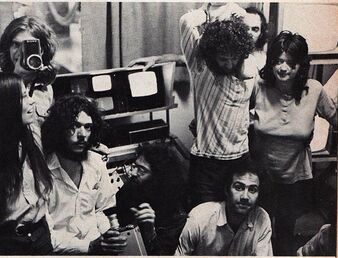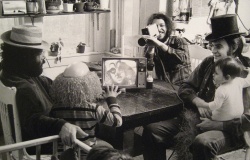Difference between revisions of "Videofreex"
m (Text replacement - "imagesize = 250px" to "imagesize = 342px") |
m (Text replacement - "imagesize = 342px" to "imagesize = 338px") |
||
| Line 1: | Line 1: | ||
{{infobox artist | {{infobox artist | ||
|image = Videofreex.jpg | |image = Videofreex.jpg | ||
| − | |imagesize = | + | |imagesize = 338px |
|collections = [[VDB::{{VDB|videofreex}}|VDB]] 70 | |collections = [[VDB::{{VDB|videofreex}}|VDB]] 70 | ||
|web = [[Wikipedia::http://en.wikipedia.org/wiki/Videofreex|Wikipedia]] | |web = [[Wikipedia::http://en.wikipedia.org/wiki/Videofreex|Wikipedia]] | ||
Revision as of 23:09, 25 May 2022
 | |
| Web | Wikipedia |
|---|---|
| Collections | VDB 70 |
The Videofreex were a pioneering video collective who used the Sony Portapak for counter-cultural video projects from 1969 to 1978.
Contents
Being one of the first video collectives, it was founded in 1969 by David Cort, Curtis Ratcliff and Parry Teasdale, after David and Parry met each other, video cameras in hand, at the Woodstock Music Festival. The group soon grew to ten full-time members--including Chuck Kennedy, Nancy Cain, Skip Blumberg, Davidson Gigliotti, Carol Vontobel, Bart Friedman and Ann Woodward--and produced tapes, installations and multimedia events. In 1971 the Freex moved to a 17-room, former boarding house called Maple Tree Farm in Lanesville, NY, operating one of the earliest media centers. Their innovative programming ranged from artists' tapes and performances to behind-the-scenes coverage of national politics and alternate culture. During the decade that the Freex were together, this pioneer video group amassed an archive of 1,500+ raw tapes and edits.[1]
Michael Shamberg, author of Guerrilla Television and founding member of TVTV remarked that "The Freex are the most production oriented of the video groups [..] in terms of finished, cleanly edited, high quality tape, which is generally quite entertaining, the Videofreex are clearly the best."[2]
Mirroring the beliefs outlined in Guerrilla Television they believed they could turn the medium of television, at the time dominated by The "Big Three" Television Networks, into a more democratic medium and in 1972 they launched the first pirate TV station, Lanesville TV, using a transmitter given to them by Abbie Hoffman.
The Videofreex Archive, containing more than 1,500 original tapes, is housed at the Video Data Bank. Work is underway to preserve important titles from the Archive and make them available through distribution.
Publications
- The Spaghetti City Video Manual: A Guide to Use, Repair, and Maintenance, Holt Rinehart & Winston, 1973.
Literature
- Books
- Deidre Boyle, Subject to Change: Guerrilla Television Revisited, Oxford University Press, 1997.
- Parry Teasdale, Videofreex: America’s First Pirate TV Station & the Catskills Collective That Turned It On, Hensonville: Black Dome Press, 1999.
- Nancy Cain, Video Days and What We Saw Through the Viewfinder, Palm Springs: Event Horizon Press, 2011.
- Articles
- Ann Woodward, "The Spaghetti City Video Manual (1973) and 'Jungletown TV On-the -Air' (1975)", PAJ: A Journal of Performance and Art 71 (Volume 24, Number 2), May 2002, pp 8-9.
- Randall Packer, "Videofreex Chronicles #1: TV as Social Media", 13 Jul 2015.
- Kris Paulsen, "Steal This Station: Videofreex and the Radical Banality of Pirate Broadcasting", Media-N 12:3, 2017. Review of Jenny Raskin and Jon Nealon's film Here Come the Videofreex.
- Liz Flyntz, "Media Ecology and Cultural Climate Change: A Weekend with the Videofreex", Afterimage 47:1, 2020, pp 19-33.
Documentary
- Here Come The Videofreex, dir. Jenny Raskin and Jon Nealon, 2015. Trailer.


